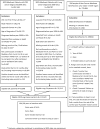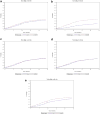Breast Cancer Screening in Patients With Newly Diagnosed Lung and Colorectal Cancer: A Population-Based Study of Utilization
- PMID: 28325489
- PMCID: PMC5588859
- DOI: 10.1016/j.jacr.2017.01.022
Breast Cancer Screening in Patients With Newly Diagnosed Lung and Colorectal Cancer: A Population-Based Study of Utilization
Abstract
Purpose: To assess breast cancer screening utilization in Medicare beneficiaries with colorectal and lung cancer versus cancer-free controls.
Methods: Female fee-for-service Medicare beneficiaries who were ≥67 years old and diagnosed with lung or colorectal cancer between 2000 and 2011 and who reported to a Surveillance, Epidemiology, and End Results (SEER) registry (case group) were followed for 2 years after their diagnoses, unless death, a diagnosis of breast cancer, or the end of 2013 came first. A similar number of cancer-free controls were individually matched to cases by age, race, registry region, and follow-up time. Screening utilization was defined as the percentage of women with ≥1 screening mammogram during follow-up.
Results: Overall, 104,164 cases (48% colorectal, 52% lung; 30% advanced cancer) and 104,164 controls were included. Among women with lung or colorectal cancer, 22% underwent ≥1 screening mammogram versus 26% of controls (odds ratio [OR] 0.80; 95% confidence interval [CI] 0.78-0.82). Stratified by cancer type, 28% of colorectal cancer cases versus 29% of controls (OR 0.98; 95% CI 0.95-1.01) and 17% of lung cancer cases versus 23% of controls (OR 0.63; 95% CI 0.60-0.65) received ≥1 mammogram. When stratified by stage, 8% with advanced cancer versus 18% of controls (OR 0.33; 95% CI 0.31-0.35) and 30% with early-stage cancer versus 30% of controls (OR 1; 95% CI 0.97-1.02) underwent ≥1 mammogram.
Conclusion: Screening mammography utilization rates are similar between Medicare beneficiaries with early-stage cancer versus controls. Although the majority of patients with advanced-stage cancer appropriately do not pursue screening mammography, a small number (8%) continue with screening.
Keywords: Screening mammography; cancer survivorship period; population-based; utilization.
Copyright © 2017 American College of Radiology. Published by Elsevier Inc. All rights reserved.
Conflict of interest statement
The authors have no conflicts of interest related to the material discussed in this article.
Figures


Similar articles
-
Downstream Breast Imaging Following Screening Mammography in Medicare Patients with Advanced Cancer: A Population-Based Study.J Gen Intern Med. 2018 Mar;33(3):284-290. doi: 10.1007/s11606-017-4212-x. Epub 2017 Nov 14. J Gen Intern Med. 2018. PMID: 29139055 Free PMC article.
-
Cancer screening among patients with advanced cancer.JAMA. 2010 Oct 13;304(14):1584-91. doi: 10.1001/jama.2010.1449. JAMA. 2010. PMID: 20940384 Free PMC article.
-
Can Medicare billing claims data be used to assess mammography utilization among women ages 65 and older?Med Care. 2006 May;44(5):463-70. doi: 10.1097/01.mlr.0000207436.07513.79. Med Care. 2006. PMID: 16641665
-
Current situation of screening for cancer.Ann Oncol. 2002;13 Suppl 4:189-98. doi: 10.1093/annonc/mdf659. Ann Oncol. 2002. PMID: 12401689 Review. No abstract available.
-
Screening utilization among cancer survivors: a meta-analysis.J Public Health (Oxf). 2018 Mar 1;40(1):129-137. doi: 10.1093/pubmed/fdx030. J Public Health (Oxf). 2018. PMID: 28334835
Cited by
-
Updated Overview of the SEER-Medicare Data: Enhanced Content and Applications.J Natl Cancer Inst Monogr. 2020 May 1;2020(55):3-13. doi: 10.1093/jncimonographs/lgz029. J Natl Cancer Inst Monogr. 2020. PMID: 32412076 Free PMC article. Review.
-
Comparative Analysis of the Trends in Medical Utilization of Cancer Inpatients in Korea.Osong Public Health Res Perspect. 2017 Oct;8(5):342-350. doi: 10.24171/j.phrp.2017.8.5.08. Epub 2017 Oct 31. Osong Public Health Res Perspect. 2017. PMID: 29164046 Free PMC article.
-
Downstream Breast Imaging Following Screening Mammography in Medicare Patients with Advanced Cancer: A Population-Based Study.J Gen Intern Med. 2018 Mar;33(3):284-290. doi: 10.1007/s11606-017-4212-x. Epub 2017 Nov 14. J Gen Intern Med. 2018. PMID: 29139055 Free PMC article.
References
-
- Siegel R, Ma J, Zou Z, Jemal A. Cancer statistics, 2014. CA Cancer J Clin. 2014;64:9–29. - PubMed
-
- Travis LB, Rabkin CS, Brown LM, et al. Cancer survivorship—genetic susceptibility and second primary cancers: research strategies and recommendations. J Natl Cancer Inst. 2006;98:15–25. - PubMed
-
- Buiatti E, Crocetti E, Acciai S, et al. Incidence of second primary cancers in three Italian population-based cancer registries. Eur J Cancer. 1997;33:1829–34. - PubMed
MeSH terms
Grants and funding
LinkOut - more resources
Full Text Sources
Other Literature Sources
Medical

